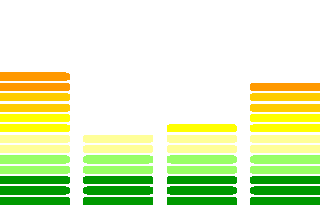OBJECTIVE: To determine specific gravity of a liquid, using measuring Beaker: Eureka can density bottle method.
APPARATUS: Measuring Beaker, Eureka Can, Density Bottle, Balance, Water liquid,Solid object, vernier ect.
THEORY:
Specific gravity, also called Relative Density, of a substance may be defined as the ratio of its mass density to the mass density to the water taken at atmospheric pressure at 4 degree Celsius. Since it is a ratio, specific gravity has no unit.
Mass density is defines as the mass of material per unit volume. So to determine density of a liquid it is necessary to determine the mass of a know volume of liquid. Measurement of volume must be done with due care.
PROCEDURE:
(a) Using measuring Beaker Method
1. Weigh the empty measuring beaker using a suitable balance and record the mass.
2. Fill the beaker with water and read the volume as accurately as possible. Record the volume.
3. Weigh the beaker plus water and record the mass. The mass of water can be calculated by subtracting mass of empty.
4. Determine mass density as
P = mass in gram or mass in Kg
Volume in ml volume in m3
5. Calculate average mass density
6. Repeat above steps using given using given liquid in place of water
7. Calculate specific gravity as
SG = _p_
pw
(b) Using Eureka Can method:
The Eureka Can is a container with a fixed spout. If filled until overflow from the spout, the final lever when the liquid has stopped flowing will always be the same provided the can is lever and the liquid is not contaminated. If the can is initially full and a solid object is placed in it, a volume of liquid will be displaced equal to the volume of the object. This us a basic method of obtaining a know volume of liquid.
1. Take a solid object (cylinder or cube) which may fit in the Eureka Can.
2. Accurately measure dimensions of the object, calculate its volume and record the volume.
3. Place the Eureka Can at the edge on the working surface and fill it with water until it overflows.
4. Weigh an empty beaker, record its mass and place this under the spout.
5. Carefully lower the objects into the can until fully immersed and collect the displaced water in the beaker.
6. Weigh the beaker plus collected water and record the mass. The mass of the water can be calculated by subtracting mass of empty beaker.
7. Calculate mass density.
8. Repeat the above procedure using given liquid in place of water.
9. Calculate specific gravity of the liquid.
(c) Using Density Bottle Method:
1. Dry the bottle and stopper.
2. Weigh the bottle with stopper and record the weight.
3. Fill the bottle with water and replace the stopper.
4. Carefully dry the outside of the bottle with a cloth or tissue paper and remove any excess the water from the stopper such the liquid in the hole is level with the top of the stopper.
5. Volume of water is 100 cm3 (ml) when the water is level with the top of the stopper.
6. Weigh the bottle with stopper and water. Record the mass. The mass of water may be calculated by subtracting mass of empty bottle with stopper.
7. Calculate mass density.
8. Repeat the above method using the given liquid in place of water.
9. Calculate specific gravity of the liquid.
OBSERVATIONS AND RESULTS:
(a) Using Measuring Beaker Method:
For Water.
S.No | Wt. of empty beaker (gm) | Wt. of beaker + water (gm) | Mass of water (3-2)(gm) | Vol. of Water (cm3) | Mass density of water (4/5) g/cm3 |
(1) | 2 | 3 | 4 | 5 | 6 |
1 | 100.5 | 147.0 | 46.5 | 50 | 0.930 |
2 | 100.5 | 195.9 | 95.4 | 100 | 0.954 |
3 | 100.5 | 246.8 | 146.3 | 150 | 0.975 |
Average pwater = 0.95311 gm/ cm3.
For liquid.
S.No | Wt. of empty beaker (gm) | Wt. of beaker + liquid (gm) | Mass of liquid (3-2)(gm) | Vol. of liquid (cm3) | Mass density of liquid (4/5) g/cm3 |
(1) | 2 | 3 | 4 | 5 | 6 |
1 | 100.5 | 159.0 | 58.5 | 50 | 1.170 |
2 | 100.5 | 216.8 | 116.3 | 100 | 1.163 |
3 | 100.5 | 278.6 | 178.1 | 150 | 1.187
|
Average pliquid = 1.187344 gm/ cm3.
Specific gravity of liquid = Pliquid = 1.2457
P pwater
(b) Using Eureka Can Method
Volume of Solid Object V =32.04cm3
For water:
S.No | Wt. of empty beaker (gm) | Wt. of beaker + water (gm) | Mass of water (3-2)(gm) | Mass density of water (4/5) g/cm3 |
(1) | 2 | 3 | 4 | 5 |
1 | 25.1 | 53.8 | 28.7 | 0.896 |
2 | 25.2 | 54.8 | 29.6 | 0.924 |
3 | 25.1 | 52.8 | 27.7 | 0.865 |
Average pwater = 0.895 gm/ cm3.
For Liquid:
S.No | Wt. of empty beaker (gm) | Wt. of beaker + liquid (gm) | Mass of liquid (3-2)(gm) | Mass density of liquid (4/5) g/cm3 |
(1) | 2 | 3 | 4 | 5 |
1 | 18.4 | 54.3 | 35.9 | 1.120 |
2 | 18.4 | 53.1 | 34.7 | 1.083 |
3 | 18.4 | 45.3 | 26.9 | 0.594 |
Average pliquid = 0.932333gm/cc.
Specific gravity of liquid = Pliquid = 1.042
Pwater
(c) Using Density Bottle Method
For water:
Volume of water = 100 cm3
S.No | Wt. of empty beaker (gm) | Wt. of beaker + water (gm) | Mass of water (3-2)(gm) | Mass density of water (4/5) g/cm3 |
(1) | 2 | 3 | 4 | 5 |
1 | 50.6 | 151.8 | 101.2 | 1.012 |
2 | 50.6 | 151.8 | 101.2 | 1.012 |
3 | 50.6 | 151.7 | 101.1 | 1.011 |
Average Pwater = 1.012gm/cc
For Liquid:
S.No | Wt. of empty beaker (gm) | Wt. of beaker + liquid (gm) | Mass of liquid (3-2)(gm) | Mass density of liquid (4/5) g/cm3 |
(1) | 2 | 3 | 4 | 5 |
1 | 50.6 | 173.1 | 122.5 | 1.225 |
2 | 50.6 | 173.2 | 122.6 | 1.226 |
3 | 50.6 | 173.1 | 122.5 | 1.225 |
Average pliquid = 1.225gm/cc
Specific gravity of liquid = Pliquid = 1.210
P pwater
DISCUSSION OF RESULTS:
Hint:
( i ) What may the reason for different methods giving different result? Mistake in measuring and reading
(2) Which types of Eureka Can give you accurate result, a narrow, deep can or wide shallow can?
Wide shallow can give the accurate results.
CONCLUSION AND RECOMMEDATION:












